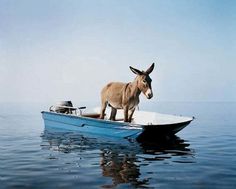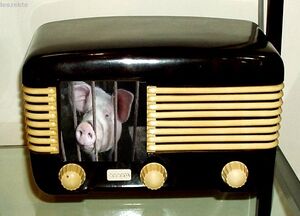QSL Burro

The QSL Burro is one of several techniques in the animal kingdom that amateur radio operators use to confirm they have listened to one another, given that radio itself works so poorly and even postal mail communicates more rapidly.
This legendary pack animal has faithfully transported "QSL cards" since the earliest days of ham radio. Sometimes misspelled QSL Bureau or QSL Buro, the QSL Burro system was once mistakenly attributed to Hämlich Hertz, the 19th-Century tycoon of mule-drawn carriage rentals, or Nikolai Tefla, the inventor of the non-stick wireless coil. In fact, DNA testing proved that Italian inventor Gigolo Macaroni was the father of using pigs to produce emissions into ether. (Any Michigander with a working knowledge of pig emissions knows why Macaroni did not own up to his role.)
Unfortunately, having spent all his liras on Pig Chow, Marconi could not afford a postage stamp for the first QSL card, so he trained his donkey to deliver it to the receiving pig on the other side of his farm.
The QSL Burro has been featured on Animule Planet.
Limitations[edit]
The limitations of the QSL Burro became evident as the distances successfully spanned by pig emissions progressively increased.
- The maximum velocity of the burro was 3 km/h or even slower, as when it took several years for the burro to cross the ocean on a raft to confirm the first Transatlantic signals.
- The QSL Burro service is not yet available for contacts with the Astronomical Space Station (ASS). The primary obstacle is getting a helmet to fit over its head.
- In times of famine, the QSL Burro has been known to eat QSL cards. At those times, ham radio operators are advised to use an alternate delivery system.
New technology[edit]
Technology has somewhat improved reliability of the QSL Burro since the FCC assigned it use of the 220-222 MHz radio spectrum. This band, also known as the 12 cm band, is the distance between the ears of the QSL Burro. On this natural resonant frequency, the ears form a horizontally polarized, independently steerable, diversity reception array used for global positioning and long-range navigation.
Modern miniaturization of the components of the QSL Burro has produced a smaller device that can confirm the reception of a station. This is called the QSL Burrito and is available in multi-packs for Jamborees and Hamfests.
Future challenges[edit]
The QSL Burro is an endangered species due to the increasing use of eQSLs.
The increasing greenhouse effect of pig ether emissions has also rendered the QSL Burro susceptible to overheating, though Burro emissions are solid-state and Burrito emissions are not. Much like aging racing greyhounds and rock stars, QSL Burros and Burritos are placed in willing homes after the end of their service lives, and the charity that does so always welcomes donations.
See also[edit]
| |||||||||||||


